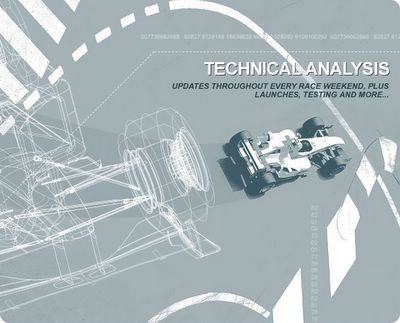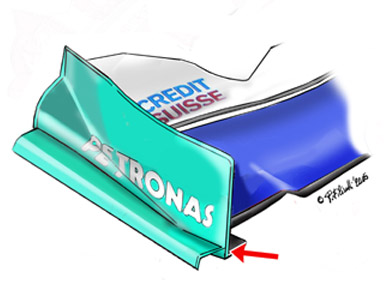Sunday, May 29, 2005
EUROPEAN GP 2005 TECHNICAL ANALYSIS
Renault R25 - rear-light wing
Already seen on other cars, at the Nurburgring Renault introduced a small wing on top of the rear light. Roughly 15 cm wide, it is connected to the light cover and crushable structure by means of a tiny pillar. This device helps with the extraction of air from the bottom of the car by means of a depression that it creates right behind the rear diffuser's central section.
Also seen in Monaco, Williams' Nurburgring winglets are based on a series of double profiles. The fronter-most winglets (in blue, next to the cooling chimney) have a lower profile that also acts as the structure's support mounting. The rearmost winglets (white) also sport a double profile at their rear, connected by a small vertical endplate. These changes are, of course, to optimise the aerodynamics at the rear of the car and to increase downforce.
For the Nurburgring race Jordan adopted some of the largest cooling chimneys in the paddock. The only obvious reason is the weather, which has been much hotter and more humid than is typical for the region at this time of the year.
A curious chimney design for the European round. Curious because the top is closed, hence they don't have the function of hot-air venting. Also curious because they are visibly curved outwards, not just inclined as on most cars. Their main function therefore looks to be diverting airflow outwards, away from the rear wheels, to reduce turbulence and refine the airflow impacting the rear wing.
Adding small pointed fins to the external edge of barge boards, close to their sidepod link, has become increasingly popular since their first appearance on last year's Renault at Monaco. At the Nurburgring McLaren have introduced a triangular fin on the right-hand barge board only. This asymmetrical approach is down to the track being clockwise (as most are) - the right side of the car is the most effected by the airflow directed beneath it in corners. The new fins help limit those effects.
For BAR's return at the Nurburgring these follow a trend seen on other cars in recent races. The main turning vane is a horizontal fin, extending outwards from the outer-front edge of the sidepod (right-hand arrow). This is coupled with a horizontal, wing-shaped splitter at the same level (left-hand arrow). The aim is to improve the aerodynamic efficiency of the bottom of the car and is an area being constantly evolved by most teams this year.
Introduced at Monaco, but retained for Europe due to their positive effect on the car's front aero balance, these endplates feature a lower channel (red arrow), increasing the overall width of the wing. The channel has a vent hole at the rear allowing air to pass through (blue arrow), reducing turbulence and refining the airflow to the bottom of the car.
A change for the Nurburgring, seen briefly, but not raced at Monaco. The previously semi-circular section to the endplate's lower channel now has a much flatter shape at its top, a solution not dissimilar to that seen on the McLaren in Monte Carlo. This revision reduces the pitch sensitivity of the car's front end.








